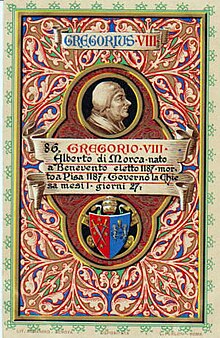Pope Gregory VIII
Gregory VIII | |
|---|---|
| Bishop of Rome | |
| Church | Catholic Church |
| Papacy began | 21 October 1187 |
| Papacy ended | 17 December 1187 |
| Predecessor | Urban III |
| Successor | Clement III |
| Orders | |
| Consecration | 25 October 1187 |
| Created cardinal | 1156 byAdrian IV |
| Personal details | |
| Born | Alberto di Morra c. 1100/1105 |
| Died | 17 December 1187 Pisa,Republic of Pisa |
| Other popes named Gregory | |

Pope Gregory VIII(Latin:Gregorius VIII;c. 1100/1105 – 17 December 1187), bornAlberto di Morra,was head of theCatholic Churchand ruler of thePapal Statesfor two months in 1187. Becoming Pope after a long diplomatic career as Apostolic Chancellor, he was notable in his brief reign for reconciling the Papacy with the estrangedHoly Roman Empireand for initiating the Third Crusade.
Early life
[edit]Alberto di Morra was born about 1105 inBenevento.His father was the nobleman Sartorius di Morra. He became a monk early in life, either as aCistercianinLaon,or aBenedictineatMonte Cassino.Alberto later joined a new religious order, thePremonstratensianor Norbertine order, probably between the ages of 20–30. He was a canon at St. Martin's Abbey in Laon.[1]He later became a professor ofcanon lawinBologna.
Cardinal
[edit]In 1156,Pope Adrian IVmade himcardinal-deaconof Sant'Adriano, and on 14 March 1158 he becamecardinal-priestofSan Lorenzo in Lucina.As apapal legateofPope Alexander III,he was sent to teach canon law throughout Europe in the 1160s, and was sent toPortugalto crownAfonso I.He also brought an offer of reconciliation in 1163 toHoly Roman EmperorFrederick I Barbarossa,whom Pope Alexander III had excommunicated in 1160. Alexander also sent him to England to investigate the murder ofThomas Becket,and he absolvedKing Henry IIof the murder during theCouncil of Avranches.From 1177 to 1179, Alberto also served as a legate in Italy and in February 1178 was namedChancellor of the Holy Roman Church.As Chancellor he generally pursued a conciliatory line toward the Emperor; in the controversy over the disputed succession of theArchbishop of Trierhe argued strongly in favor of setting aside both the pro-papal candidateFolmar of Kardenand the pro-imperialRudolf of Wied,and allowing the canons of Trier to hold a new election, but was overruled byPope Urban III.[2]It was in this position that di Morra "...compiled aForma Dicendi,a collection of official papal acts, and also completed a codification of the cursus, a compilation of the very stringent rules governing the euphonious arrangements of sentence endings and phrasing in papal acts. In his honor, the cursus was calledstylus gregorianus."[3]These two documents were very influential in shaping the rhetoric used in papal documents. Shortly before his election to the papacy, Alberto founded a monastery in his hometown of Benevento.
Papacy
[edit]On 21 October 1187, the day after the death of Urban III, Alberto di Morra, at that timeProtopriestof theCollege of Cardinals,waselected pope(afterHenry of Marcyhad withdrawn his name from consideration), and took the name Gregory VIII in honour ofGregory VII.He was consecrated on 25 October. His previous dealings with Frederick Barbarossa put the church back in a friendly relationship with the Holy Roman Emperor. In response to the defeat of thecrusaderKingdom of Jerusalemat theBattle of Hattin,Gregory issued thepapal bullAudita tremendicalling for theThird Crusade.[4]Gregory travelled toPisain order to end Pisan hostilities withGenoaso that both seaports and naval fleets could join together for the crusade. On the way to Pisa, he stopped atLuccaand orderedAntipope Victor IV's body to be removed from his tomb and his remains thrown out of the church.,
Death
[edit]
Gregory died in Pisa on 17 December 1187 of a fever after holding the papacy for only 57 days. He was buried in theDuomo in Pisa;the tomb and the papal remains were destroyed in the 1600 fire of the Cathedral. He was succeeded byClement III.According to Joseph S. Brusher, "His pontificate though brief was glorious."[5]
See also
[edit]References
[edit]- ^"Gregory, the eighth of that name...they declare from records of St. Martin of Laon to have once been a canon of that church..." Basil R. Reuss, "A Norbertine Pope?," rev. of Catholic University of America Press, The Catholic Historical Review July 1933: 200-03 <https://www.jstor.org/stable/25013158>.
- ^Geschichte der deutschen Kaiserzeit,Vol. VI, p. 130.
- ^Philippe Levillain, ed. The Papacy: An Encyclopedia, New York: Routledge, 2002, 653.
- ^J. N. Kelly, The Oxford Dictionary of Popes, New York: Oxford UP, 1986, 183.
- ^Joseph S. Brusher,Popes through the Ages,342.
Bibliography
[edit]- Brusher, Joseph S. Popes through the Ages.
- Delaney, John J., and James E. Tobin. Dictionary of Catholic Biography. New York, NY: Doubleday, 1961.
- Falconieri, Tommaso di Carpegna (2000)."Gregorio VIII".(in Italian)Enciclopedia dei Papi(Treccani 2000).
- Giesebrecht, Wilhelm von & Simson, Bernhard von (1895),Geschichte der deutschen Kaiserzeit,vol. VI, Leipzig: Duncker & Humblot,available at theInternet Archivehere:Volume VI.(in German)
- Kelly, J. N. The Oxford Dictionary of Popes. New York: Oxford UP, 1986.
- Levillain, Philippe, ed. The Papacy: An Encyclopedia. New York: Routledge, 2002.
- Loughlin, James."Pope Gregory VIII."The Catholic Encyclopedia. Vol. 6. New York: Robert Appleton Company, 1909. 7 December 2008.
- "Premonstratenisans/Norbertines A Look at out Way of Life."The International Website for the Order of Premontre. The Order of Premontre. 7 December 2008.
External links
[edit] Media related toPope Gregory VIIIat Wikimedia Commons
Media related toPope Gregory VIIIat Wikimedia Commons Works by or aboutGregory VIIIatWikisource
Works by or aboutGregory VIIIatWikisource Quotations related toPope Gregory VIIIat Wikiquote
Quotations related toPope Gregory VIIIat Wikiquote
